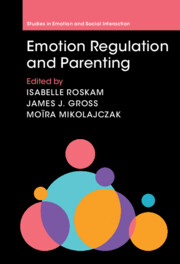Book contents
- Emotion Regulation and Parenting
- Studies in Emotion and Social Interaction
- Emotion Regulation and Parenting
- Copyright page
- Contents
- Figures
- Tables
- Contributors
- Preface
- Part I Conceptual Foundations
- Part II Influence of Parents’ Emotion Regulation on Parenting
- Part III Influence of Parenting on Child Emotion Regulation
- Chapter 7 Parental Coregulation of Child Emotions
- Chapter 8 Parental Assistance with Children’s Extrinsic Emotion Regulation across Development
- Chapter 9 Parental Socialization of Children’s Emotion and Its Regulation
- Part IV Current Trends
- Index
- Studies in Emotion and Social Interaction
- References
Chapter 8 - Parental Assistance with Children’s Extrinsic Emotion Regulation across Development
from Part III - Influence of Parenting on Child Emotion Regulation
Published online by Cambridge University Press: 05 January 2024
- Emotion Regulation and Parenting
- Studies in Emotion and Social Interaction
- Emotion Regulation and Parenting
- Copyright page
- Contents
- Figures
- Tables
- Contributors
- Preface
- Part I Conceptual Foundations
- Part II Influence of Parents’ Emotion Regulation on Parenting
- Part III Influence of Parenting on Child Emotion Regulation
- Chapter 7 Parental Coregulation of Child Emotions
- Chapter 8 Parental Assistance with Children’s Extrinsic Emotion Regulation across Development
- Chapter 9 Parental Socialization of Children’s Emotion and Its Regulation
- Part IV Current Trends
- Index
- Studies in Emotion and Social Interaction
- References
Summary
Across development, parents play a critical role in assisting children in regulating emotions via extrinsic emotion regulation (ER). Cross-species evidence suggests that parental influences on corticolimbic circuitry – thought to underlie ER – peak in childhood and wane during the transition to adolescence as children increasingly rely on intrinsic regulation strategies. Gottman’s parental meta-emotion philosophy laid important groundwork for recent advances in assessment of parental assistance with children’s use of specific ER strategies, a line of work that has the potential to further understanding of how parents socialize children’s reliance on certain ER strategies. Initial evidence suggests that the strategies parents assist with may vary as a function of child age and parent-level factors such as psychopathology and reliance on specific intrinsic ER strategies. We discuss future directions in the study of parental assistance with children’s ER focused on further understanding normative developmental trajectories of parents’ assistance with specific ER strategies and neurobiological correlates of specific profiles of parental assistance.
Keywords
- Type
- Chapter
- Information
- Emotion Regulation and Parenting , pp. 149 - 165Publisher: Cambridge University PressPrint publication year: 2023



